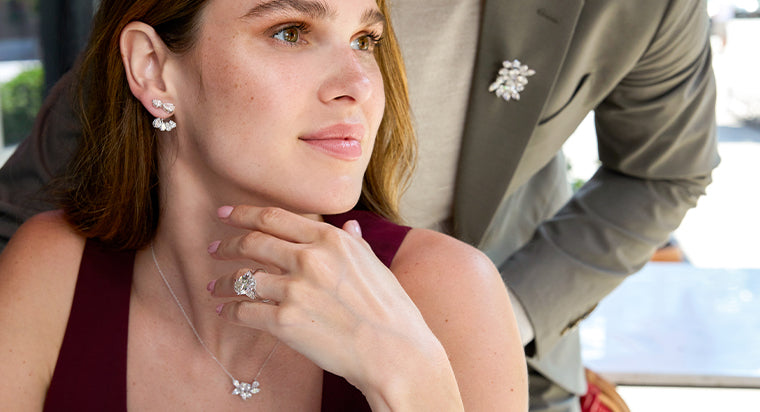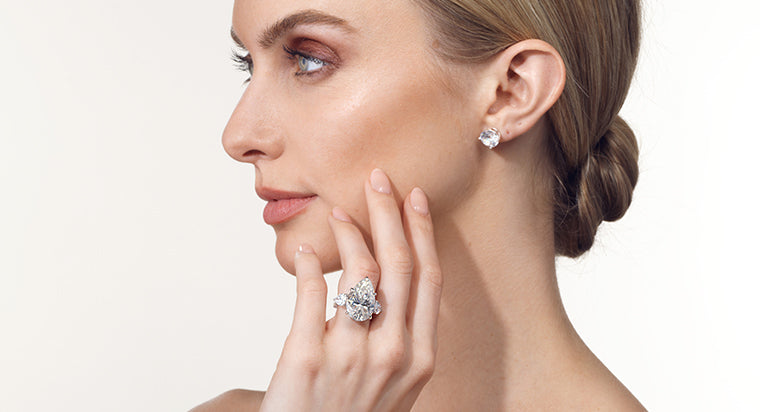Buying Guide for Wedding Bands

Getting married is a big deal! But amid all the excitement of planning your wedding, choosing your wedding band might seem like a simple task. After all, it's “just a ring,” right? However, many couples quickly discover that this is no easy feat.
You want your wedding bands to be more than just a beautiful piece of jewelry—they should depict your love story and lifelong commitment while also showcasing your personality. Plus, it's also a ring you'll likely wear every day, so it deserves a bit of thought.
But where does one start? How do you sift through all the designs, metals, and styles to find the perfect one? What about diamonds or gemstones? Should you pick matching couples' bands?
It sounds like a lot. But here's the good news: We've put together a buying guide with a lowdown on how to choose the perfect diamond wedding ring for your budget, preferences, and lifestyle.
TABLE OF CONTENTS
Wedding Band Basics
A wedding band (or a wedding ring) is a ring exchanged during your wedding ceremony to symbolize your marital vows. They're typically worn on the left hand on the fourth finger or the “ring finger” as it's believed that the veins directly run from this finger to the heart.
In case you were wondering if wedding bands symbolize anything: They do!
Wedding bands don't have a beginning or an end—the continuous circle represents eternal bonds, unbreakable promises, and everlasting commitment that two people have for one another. Although it's a tiny ring, it has a lot of meaning.
How To Choose A Wedding Band?
1. Setting Your Budget
Before you start shopping for wedding bands, figure out how much you're comfortable spending. Prices can vary significantly depending on the metal chosen, the level of customization, and the quantity of diamonds and gemstones selected.
Pro Tip: Remember, this is the ring you'll wear daily, so choose something that fits your budget but is also durable and of high quality. It's an investment you'll treasure for a lifetime.
2. Choosing the Right Metal
The metal you pick sets the tone for your wedding band's entire look and affects how it wears over time.
Yellow gold offers a warm, classic look, perfect for a traditional bride. White gold wedding bands have a sleek, modern feel, although they may need occasional replating to maintain shine. Rose gold offers a romantic pink hue and can be a good option if you want a ring that's unique and elegant. Then there's platinum—rare, enduring, and precious, much like true love itself—celebrated for its natural white color, incredible durability, and hypoallergenic properties. However, it does come at a higher price.
Many couples choose wedding bands in the same metal as their engagement ring for a cohesive look-- but no rule says you have to. Wearing mixed metal rings looks visually stunning and makes for a beautiful stack.
3. Selecting the Band Design
It's time for the fun part: selecting the design of your wedding band. You'll see plenty of different looks, from simple to extravagant. Some of our favorite design ideas are:
Classic Plain Bands: They're timeless, elegant, and easy to maintain. Plus, they will complement any engagement ring and typically cost less than other styles, making this band style an excellent option for couples on a budget.
-
Diamond or Gemstone Bands: If you prefer a wedding band that shines, diamond and gemstone bands are a brilliant option.
Diamond wedding rings are super sparkly and look elegant, making them a dazzling option for any bride-to-be. They're also the most durable gemstone, which makes them perfect for daily wear. Having said that, natural diamonds can also be expensive, so you may want to consider a wedding band with lab-grown diamonds if you're on a tight budget.

Gemstone bands are a lovely way to add some vibrance and color to your wedding ring. They're perfect if you're looking for something unconventional. However, keep in mind that they may not have the same durability as diamond wedding bands.

-
Eternity vs. Half-Eternity Bands: Diamond wedding bands are available in two styles: Eternity bands and half-eternity bands. Eternity rings have diamonds that go all the way around the band, symbolizing endless love without any end or beginning. They're super sparkly, but can be a bit expensive. Half-eternity bands feature diamonds that go only halfway around the ring, but they still convey the same symbolism and can be cheaper in comparison.
Both designs look gorgeous! Some people find the half-eternity band more comfortable for everyday wear, but ultimately, it comes down to personal preference.


Stackable Bands: You might not have considered this idea, but you could get a couple of thin wedding bands (crafted with metal or diamonds) and stack them on either side of your engagement ring. They add a touch of sparkle and give a unique, stacked look. You can even continue to add to your stack with anniversary or birthday presents.
-
Curved & Contoured Bands: If you have a unique engagement ring, you could get a curved or contoured band that perfectly matches your engagement ring. Curved wedding bands, also known as contour bands, are designed with a curve or dip on one side, allowing them to sit snugly against an engagement ring. This style works best for brides who want a seamless, cohesive look without gaps between the two rings. Some jewelers, like With Clarity, even show you wedding bands that pair well with their engagement ring designs, making it easier to create a set that sits together flawlessly.


4. Finding the Right Fit & Comfort
It's essential to consider your lifestyle, particularly if you intend to wear your wedding ring daily. If you're highly active, consider lower-profile bands with rounded edges to prevent the stones from getting caught on anything and ensure the ring remains comfortable to wear while you're out and about. Platinum wedding bands are an excellent choice, as they can withstand more wear and tear without losing their shine.
Once you've determined your ring size, try on different options to see which one fits you the best. Comfort fit bands are great if you want to wear your ring daily. These bands have slightly curved edges to make them feel more comfortable on the finger. The width of the band also matters—a slim wedding band feels delicate and can be lighter to wear, whereas a wider band makes a more substantial statement but might feel tighter.
5. Consider Customization
Your wedding ring is your forever ring, so it only makes sense that it should be “all about you”. The best way to do this is to customize your wedding band. With Clarity lets you pick the wedding band style, metal, total carat weight, and even add an engraving. (You can even customize other types of diamond jewelry from With Clarity.) Each of these customization options makes the ring more personal.
6. Matching Wedding Bands
While it's not necessary that your wedding band has to match with your partner's ring, matching wedding bands are a beautiful way to show you’re in this together—you’re a team. You can also create your own rules when it comes to selecting them. You can go for identical rings if you have the same taste and style. Alternatively, you can choose bands that complement each other without being identical, such as matching metals with different designs or subtle details that tie them together. Remember, at the end of the day, it's all about finding a ring that feels like you as a couple.
Summary
Looking for the perfect wedding bands? This comprehensive guide helps you choose the ideal band for your budget, style, and lifestyle. Explore various metal types, including platinum and gold, as well as band styles ranging from classic to stackable, and discover tips for achieving comfort and personalization. Whether you prefer diamond wedding rings or unique designs, this guide ensures your choice reflects your love story. Shop confidently with options from With Clarity for personalized, beautiful wedding bands for women and men.
FAQs
Which metal is best for a wedding band?
How do I find the right size for my wedding band?
Should my wedding band match my engagement ring?
How do I take care of my wedding band?
How much should I budget for a wedding band?









